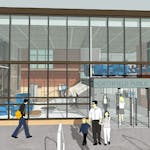Homeowners who find themselves living with more airport noise in the future could be eligible for the same type of insulation and other relief given over the years to thousands of residents near Minneapolis-St. Paul International Airport.
Minneapolis officials said on Wednesday that a court has approved extending the soundproofing program if noise increases with airport growth or for other reasons. The deal covers homes in Minneapolis, Richfield and Eagan.
Air traffic forecasts estimate that 1,131 homes in southwest Minneapolis could get initial or increased soundproofing worth $25 million, but officials caution that economic trends, aircraft types and runway use ultimately will determine the number and location of future noise mitigation efforts.
"I'm very pleased with this," said Minneapolis City Council Member Sandy Colvin Roy, who leads the council's transportation committee. She noted the decision continues noise relief that surpasses federal requirements.
But the new free soundproofing will come at a price.
"People will be harmed before they can get this," Colvin Roy said.
That's because the decision doesn't make it easier to qualify for soundproofing, just guarantees it for homes in neighborhoods that get significantly noisier over the next few years. The earliest a home could receive mitigation is 2017.
The three cities and the Metropolitan Airports Commission decided to extend a 2007 agreement that ended lawsuits and years of fighting between the agency, municipalities and homeowners over noise relief.
Under the original deal, the airport paid for abatement based on the severity of noise, and 6,659 homeowners got some kind of help. Some qualified for up to $3,025 in reimbursement for soundproofing. Others living under noise that reached 60 to 62 decibels on average could choose between $14,000 worth of soundproofing or air conditioning and $4,000 in additional soundproofing.
Homeowners within the 63 to 64 decibel range got a larger, potentially more expensive package that included doors, windows, insulation and air conditioning.
The Federal Aviation Administration oversees the use of airport revenue for noise mitigation. Last year it notified the airport that it is following a more restrictive national policy that requires sound to reach 65 decibels outdoors and 45 decibels indoors before airport funds can be used for noise abatement. The indoor requirement in particular struck city officials as unattainable because Twin Cities homes are more heavily insulated against cold than houses in many areas of the country.
The FAA later said it might allow the more generous abatement program to continue in the Twin Cities if the airport and communities agreed on a court plan to extend it. Minneapolis officials were told Wednesday that a judge recently approved the extension.
Minneapolis-St. Paul International is the only large airport in the nation to pay for mitigation of noise under 65 decibels and offers more extensive relief, airport spokesman Patrick Hogan said. But it is closer to residential areas than some new airports like Denver's.
The 1,131 homes identified earlier this year as possible recipients of future noise mitigation are mostly in the Lake Harriet area of southwest Minneapolis.
"We want to be financially prepared to respond and treat those homes like we treat other homes," said Jeffrey Hamiel, executive director of the Airports Commission.
Pat Doyle • 612-673-4504





